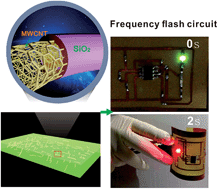Encapsulating carbon nanotubes with SiO2: a strategy for applying them in polymer nanocomposites with high mechanical strength and electrical insulation†
Abstract
Multiwalled carbon nanotubes (MWCNTs) have been widely used as mechanical reinforcement fillers for polymers during the past decades. However, the high electrical conductivity of MWCNTs hampers their applications in some specific fields. In this study, the MWCNT was encapsulated with an insulating silicon oxide (SiO2) layer to form core–shell structure MWCNT@SiO2 nanoparticles, which were used to fill bismaleimide-triazine (BT) resin. The obtained polymer nanocomposites possessed high mechanical strength, electrical insulation, improved thermal stability, and good optical transparency. These excellent properties were attributed to the strong interfacial interaction between MWCNT@SiO2 and the polymer, as well as the suppression of electron transport by the SiO2 layer on the MWCNT surface. The nanocomposites were employed to fabricate a printed circuit substrate, on which a frequency “flasher” circuit and the electrical components worked well. This work has demonstrated the possibility of using MWCNTs as mechanical reinforcement fillers in polymer nanocomposites, which simultaneously possess electrical insulation.


 Please wait while we load your content...
Please wait while we load your content...